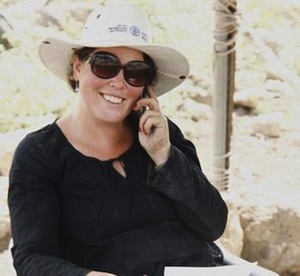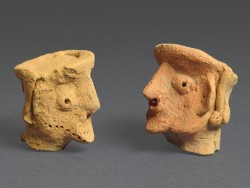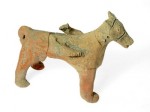A horse figurine is evidence of early Jewish ritual practice.
(photo by Clara Amit/IAA.COM)
One might think that a significant archeological find a few hours’ walk from Solomon’s Temple in Jerusalem would turn up artifacts we would recognize as Jewish. But since the Judaism of the day was not what we know, the find yielded ritual objects that seem vaguely pagan, almost heretical by today’s standards.

(photo from cjnews.com)
Shua Kisilevitz, the archeologist who was part of the team that excavated the site at Tel Motza, about seven kilometres west of Jerusalem, prefers the phrase “pagan Yahwism” to describe the religion of the era.
Last December, Kisilevitz and three fellow archeologists announced what they called an “unusual and striking” find, unearthed in construction for a highway: the 2,750-year-old walls of a temple, along with a cache of ritual objects that included a pedestal decorated with lions and sphinxes, pendants, pottery and vessel fragments, and figurines – two human and two animal – that may or may not have depicted deities.
The dig provides “rare archeological evidence for the existence of temples and ritual enclosures in the Kingdom of Judah in general and in the Jerusalem region in particular,” the team announced.
The uniqueness of the find is even more remarkable, the archeologists said, because of its proximity to the First Temple, built, according to the Bible, under King Solomon in 960 BCE. But archeologists know little about the period’s religious practices because there are hardly any remnants of ritual buildings from the era, according to Kisilevitz.
While more study is needed, the find provides valuable insights into what those rituals might have been, she said in an interview prior to her recent talk on the subject at the University of Toronto. While those practices may seem strange and un-Jewish today, they were in keeping with the rules of the time, Kisilevitz said.
Previous excavations showed that Motza functioned within the royal administration of the Kingdom of Judah, she said. “It was very much connected to Jerusalem. [It couldn’t] create its own religion. The people of Motza didn’t wake up one morning and say, ‘Oh, we want to create something new.’ They couldn’t break off so easily.”

(photo by Clara Amit/IAA.COM)
The artifacts are important because they reflect a formative time for Judaism, she noted, adding they show that the ancient Israelite faith was not always centralized in Jerusalem and its practitioners may have used ritual objects now forbidden as graven images. “There are all these presumptions we have which we project onto the early formation of religion,” Kisilevitz said. “This temple finally shows us how the religion started out and what it really looked like at the time. They [were] doing what was common in the period.”
The find also conforms to biblical accounts, which mention local religious precincts outside Jerusalem, she added. And “Motza” is mentioned in the Book of Joshua as a town in the tribal lands of Benjamin, which bordered Judah.
Kisilevitz, who works for the Israeli Antiquities Authority and is in Ontario for several months on an exchange with the University of Toronto, said the team does not know whether the human and animal figurines served a religious purpose. “It’s kind of tricky and a little bit hard to say,” she noted.
The archeological team believes the temple at Tel Motza must have functioned before religious reforms enacted in the times of kings Hezekiah and Josiah, which abolished all ritual sites outside Jerusalem and concentrated religious practices solely in the Temple.
Kisilevitz believes the artifacts do not conflict “at all” with modern understanding of Judaism. “We just have to change the way we think of the religion at the beginning.”
Ron Csillag is a Toronto freelance writer. A version of this article was originally published in the Canadian Jewish News.

